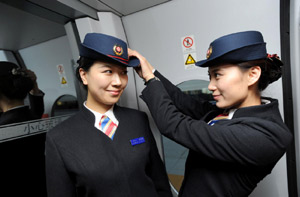
Zhou Li, director of the railway ministry's department in charge of technology, said in addition to easing a passenger transport bottleneck, the railway allows for an additional 11.5 million tonnes of cargo to be transported through the northeast China region per year.
Travel agencies have also placed high hopes on the new line boosting winter travel featuring skiing, ice sculpture and sea food.
Agency China Comfort Travel has mapped out high-quality travel routes in the three provinces, to capitalize on an anticipated "travel boom" in the winter snow sport season arriving with the operation of the highs-speed railway.
Wu Hongjian, head of the Liaoning Provincial Tourism Board, said the railway will usher in an era of "barrier-free travel" in the far-flung northeast China region.
Technical concerns
Running in temperatures as low as minus 40 degrees Celsius, the new line's safety requirements have drawn wide attention.
"In trial operation, trains ran as fast as 385 km, proof of the line's reliability," according to Zhou Li, technology official with the Ministry of Railways.
He said the ministry has conducted 22 research projects to target technology obstacles, including steady monitoring of the track condition to cope with the wide range of temperature differences in different seasons.
Still, to minimize the impact of extreme weather on operation, the ministry has created two schedules. Train speeds during the winter season (December 1 to March 31) will be limited to 200 km per hour, with the summer period (April 1 to November 30) allowing up to 300 km per hour.
Before the Harbin-Dalian line, the world had three high-speed railways running in frigid regions, including in Northern Europe and Russia, but they cannot match the length nor rapidity of China's new line. The three lines add up to a total length of less than 700 km. On the fastest of them, which links Moscow and St. Petersburg, trains can only run at a top speed of 250 km per hour for a maximum of about 20 minutes. MORE HIGH-SPEED RAILWAYS
China is aiming to create a high-speed railway backbone featuring four east-west lines and four north-south lines by the end of 2015, under a five-year transport plan approved by the State Council, China's cabinet.
The Beijing-Guangzhou high-speed railway will open for service next month.
The country's total length of high-speed railway is expected to reach about 18,000 km by 2015.
 Super rice breaks world record
Super rice breaks world record
 Xmas decorations hit the market
Xmas decorations hit the market
 Conan themed convenience store opens in Shanghai
Conan themed convenience store opens in Shanghai
 Lights on cars and models in Guangzhou
Lights on cars and models in Guangzhou
 Solar greenhouse boosts modern agriculture
Solar greenhouse boosts modern agriculture
 Crew ready for Harbin-Dalian high-speed rail
Crew ready for Harbin-Dalian high-speed rail
 Ginger vendor pursues dream of writing
Ginger vendor pursues dream of writing
 Models shine at Guangzhou auto show
Models shine at Guangzhou auto show